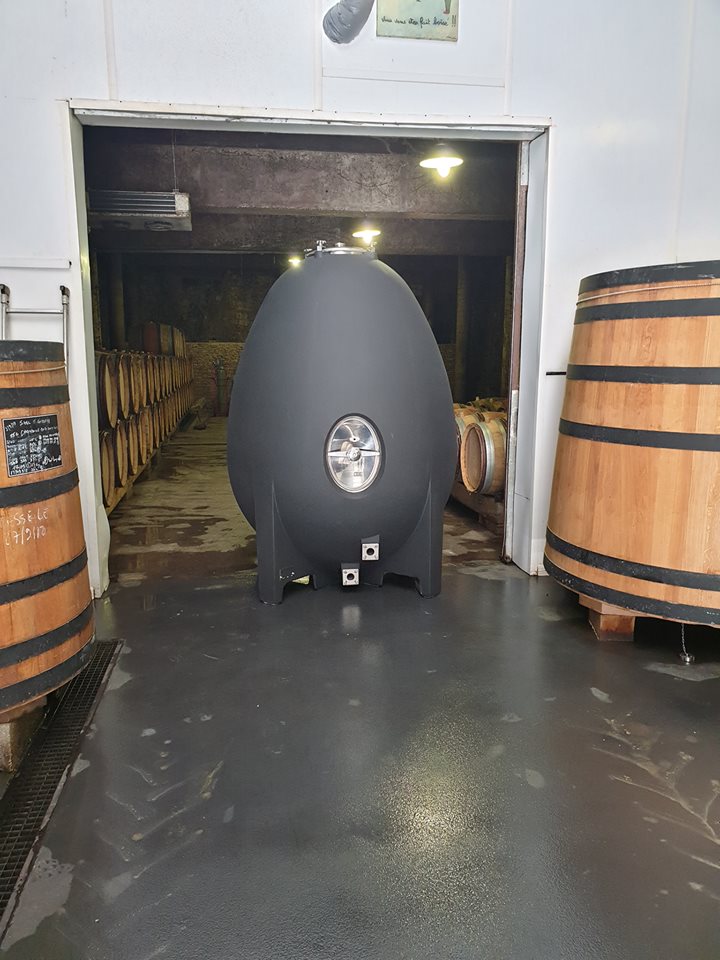
Nomblot Concrete Wine Tank Model MC 17 joined the field domain in Saint-Romain, Burgundy-Franche-Comté; photo: nomblot fb
Concrete was once the building material of choice for Le Corbusier’s bright modernist future, before becoming a cold symbol of dystopia and then rehabilitated for polite society in the 2000s. It’s been a curiously similar story with concrete in wine: back in the early 20th century, a bank of spotless concrete tanks was very much the thing for your futuristic, forward-looking winery.
As a material, it was easier to clean, more hardwearing, better insulated and cheaper than oak, which began to seem inefficient, pre-industrial and hopelessly unprogressive by comparison. By the 1980s, concrete was itself starting to look dated. Stainless steel vats, with whizzy temperature controls, available in all manner of sizes, were the kit to have, making a style of lively, fruit-driven wine that proved hugely popular. Oak, which had never gone away, was also very much back in favour, its ability to soften wine, and bring toast and vanilla flavours, now a stylistic choice to brag about.
By the turn of the millennium, concrete tanks were seen as obsolete, associated with dismal southern European co-operatives baffled by the rise of the New World. But not by everyone. Many famous estates, among them Bordeaux’s Château Petrus, had stayed true to the material. And in the Rhône, leading winemaker Michel Chapoutier was working with tank-maker Nomblot to develop equipment that would put concrete right back at the forefront of fashion.
The egg-shaped vessel it came up with had numerous advantages: as a material, concrete has some of the porosity of oak, enabling the slow, tannin-developing ingress of oxygen that stainless steel can’t deliver. Its shape naturally encourages convection currents during fermentation, circulating the dead yeast cells that bring greater texture to wine without the need for back-breaking manual stirring (known as bâtonnage), while its superior insulation maintains consistent temperature during fermentation.
Although, unlike most oak barrels, it imparts no flavour of its own, the way wine behaves inside a concrete egg stamps the finished product with a distinctive style: purity of flavour, but also an appetising complexity.
All of which has persuaded some winemakers that the egg will replace the barrel entirely once the cost, currently about £3,000, has come down. I’m not so sure. For me, the subtle interplay of wood and grape is simply too hardwired into most drinkers’ pleasure zones to give up on entirely. But, with these gorgeously curvaceous vessels, the prize exhibit at most wineries I visit these days, for now the future is undeniably – once again – concrete.
Six concrete choices

Zorzal ZZ Tupungato Malbec Cabernet Sauvignon
Mendoza, Argentina 2017
(£9.50, M&S)
Argentina’s hip young things the Michelini brothers have shown concrete eggs to be particularly good at coaxing pretty, perfumed complexity from malbec; this blend with cabernet sauvignon uses cheaper concrete tanks, but it’s no less delightful.
Domaine de Bila-Haut Les Vignes de Bila-Haut Côtes du Roussillon Villages
France 2016
(from £10.95, etonvintners.com; nywines.co.uk; noblegreenwines.co.uk)
The Roussillon outpost of the mercurial biodynamic Rhône producer Michel Chapoutier, who helped develop the original concrete egg, this is fermented and aged in concrete tanks and has a forceful clarity of sun-baked, earthy wild bramble berry.
Domaine de l’Ecu Orthogneiss, Muscadet Sèvre et Maine
France 2015
(from £13.75, L’Art du Vin; tannico.co.uk)
Exponents of the value of concrete make much of its ability to help them communicate a sense of place for their wines, something that muscadet masters achieve here with a typically deep but nervy dry white combination of citrus zing, minerals and savoury tones.
Montsecano Il Refugio Pinot Noir
Casablanca, Chile 2014
(£15, Fortnum & Mason)
As in Argentina, much of the Chilean winemaking avant-garde has used concrete eggs to distance itself from the old, heavily oaked, over-ripe ways; this is a wonderfully graceful pinot, lithe and limber, cool and fragrant with floral-inflected red fruit.
BEST BUY
Haywire White Label Gamay
Okanagan, Canada 2016
(£27, redsquirrelwine.com)
The brightest spark in the burgeoning wine scene in British Columbia’s Okanagan Valley is a true believer in concrete, in this case using it to coax gorgeous strawberry flavours and compulsively drinkable succulence from Beaujolais’ gamay grape.
Coates & Seely Britagne Brut Reserve
Hampshire, England NV
(£30.95, coatesandseely.com)
There’s a meticulousness in everything that this fine Hampshire producer does, and that includes using concrete eggs for fermentation of the base wines used to make such vividly fresh, fine-boned, dry sparklers as this classic Brut Reserve.
guardian.co.uk © Guardian News & Media Limited 2010
Published via the Guardian News Feed plugin for WordPress.

